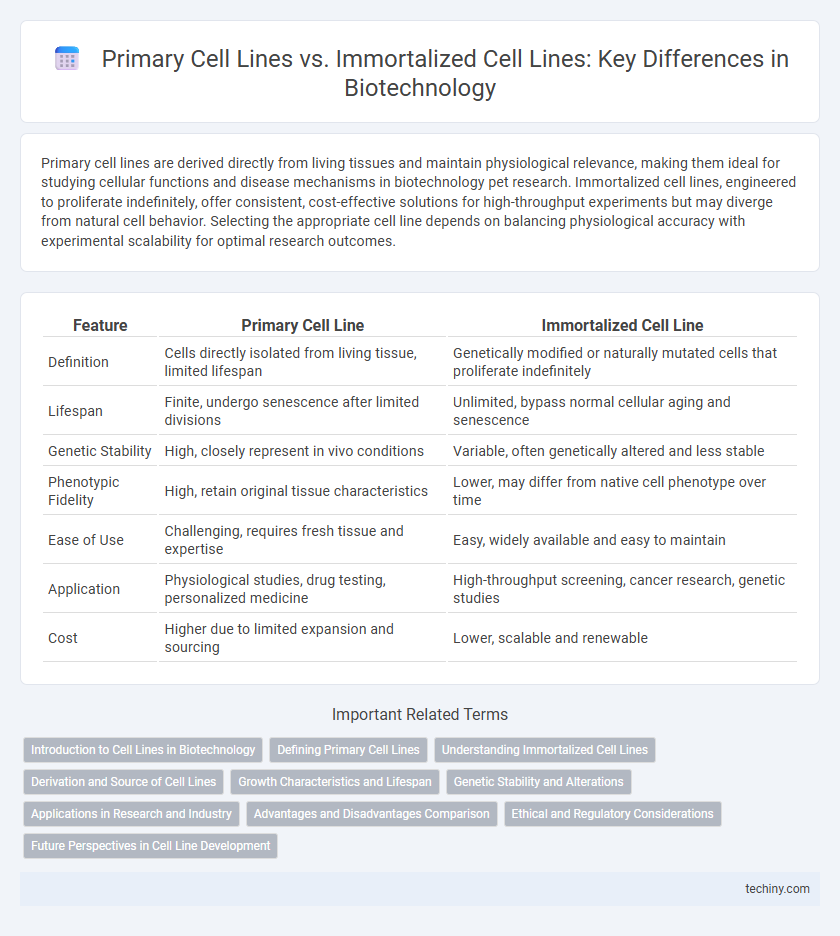Primary cell lines are derived directly from living tissues and maintain physiological relevance, making them ideal for studying cellular functions and disease mechanisms in biotechnology pet research. Immortalized cell lines, engineered to proliferate indefinitely, offer consistent, cost-effective solutions for high-throughput experiments but may diverge from natural cell behavior. Selecting the appropriate cell line depends on balancing physiological accuracy with experimental scalability for optimal research outcomes.
Table of Comparison
| Feature | Primary Cell Line | Immortalized Cell Line |
|---|---|---|
| Definition | Cells directly isolated from living tissue, limited lifespan | Genetically modified or naturally mutated cells that proliferate indefinitely |
| Lifespan | Finite, undergo senescence after limited divisions | Unlimited, bypass normal cellular aging and senescence |
| Genetic Stability | High, closely represent in vivo conditions | Variable, often genetically altered and less stable |
| Phenotypic Fidelity | High, retain original tissue characteristics | Lower, may differ from native cell phenotype over time |
| Ease of Use | Challenging, requires fresh tissue and expertise | Easy, widely available and easy to maintain |
| Application | Physiological studies, drug testing, personalized medicine | High-throughput screening, cancer research, genetic studies |
| Cost | Higher due to limited expansion and sourcing | Lower, scalable and renewable |
Introduction to Cell Lines in Biotechnology
Primary cell lines are derived directly from living tissues and maintain the physiological characteristics of the original cells, making them ideal for studying normal cell functions and responses. Immortalized cell lines, engineered to proliferate indefinitely through genetic modification or spontaneous mutation, offer a consistent and renewable resource for long-term experiments and high-throughput screening. Understanding the distinctions between primary and immortalized cell lines enhances experimental design in biotechnology, impacting drug development, disease modeling, and regenerative medicine research.
Defining Primary Cell Lines
Primary cell lines are cultures derived directly from living tissues, retaining many of the physiological properties and genetic characteristics of their original cells. They offer a realistic model for studying normal cell function, disease mechanisms, and drug responses in vitro. Unlike immortalized cell lines, primary cells have a limited lifespan and undergo senescence after a finite number of divisions.
Understanding Immortalized Cell Lines
Immortalized cell lines are genetically modified to proliferate indefinitely, unlike primary cell lines which have a limited lifespan and undergo senescence. These cell lines offer consistent growth and reproducibility, making them essential for long-term experiments in biotechnology, drug discovery, and cancer research. Understanding their genetic stability and phenotypic fidelity is crucial for interpreting experimental results accurately.
Derivation and Source of Cell Lines
Primary cell lines are derived directly from living tissues, reflecting the in vivo phenotype and genetic profile of the donor organism. Immortalized cell lines originate from primary cells that have undergone genetic modifications or spontaneous mutations, enabling indefinite proliferation in vitro. The source of primary cell lines is typically fresh biopsy or organ samples, whereas immortalized lines often stem from cancerous tissues or engineered cells with altered cell cycle regulation.
Growth Characteristics and Lifespan
Primary cell lines exhibit limited growth potential and a finite lifespan, typically undergoing senescence after a set number of divisions due to telomere shortening. Immortalized cell lines bypass replicative senescence through genetic modifications or viral oncogenes, enabling indefinite proliferation under optimal culture conditions. Growth characteristics of immortalized lines show higher mitotic rates and altered cellular morphology compared to primary cells, which more closely mimic in vivo tissue behavior.
Genetic Stability and Alterations
Primary cell lines exhibit higher genetic stability as they are directly derived from living tissues, maintaining the original genotype and phenotype without extensive alterations. In contrast, immortalized cell lines undergo genetic modifications to enable indefinite proliferation, often resulting in significant chromosomal abnormalities and mutations. These genetic alterations affect experimental reproducibility and may influence cellular responses, making primary cell lines preferable for studies requiring physiologically relevant genetic backgrounds.
Applications in Research and Industry
Primary cell lines closely mimic the physiological conditions of in vivo tissues, making them ideal for drug toxicity testing, personalized medicine, and studying disease mechanisms. Immortalized cell lines offer the advantage of extended proliferation and genetic stability, facilitating large-scale production, high-throughput screening, and genetic engineering in pharmaceutical development. Both cell line types are integral to biotechnology, with primary cells preferred for physiological relevance and immortalized lines favored for reproducibility and scalability in industrial applications.
Advantages and Disadvantages Comparison
Primary cell lines maintain native physiological characteristics and genetic stability, making them ideal for accurate in vitro modeling but exhibit limited lifespan and batch variability. Immortalized cell lines offer extended proliferation and ease of genetic manipulation, enhancing experimental reproducibility and scalability, yet can accumulate mutations and differ significantly from in vivo phenotypes. Choosing between primary and immortalized lines depends on balancing physiological relevance against experimental convenience and duration.
Ethical and Regulatory Considerations
Primary cell lines, derived directly from living tissues, present ethical concerns related to donor consent and tissue sourcing, necessitating strict adherence to regulatory guidelines such as the Declaration of Helsinki and institutional review board (IRB) approvals. Immortalized cell lines, while reducing ethical constraints tied to human or animal tissue use, require careful compliance with biosafety regulations due to their potential for genetic modification and long-term propagation. Regulatory frameworks, including the FDA and EMA, impose rigorous standards ensuring both primary and immortalized cell lines are used responsibly in research and therapeutic development.
Future Perspectives in Cell Line Development
Future perspectives in cell line development emphasize advanced gene-editing techniques such as CRISPR to create more physiologically relevant immortalized cell lines that mimic primary cell behavior closely. Innovations in induced pluripotent stem cells (iPSCs) offer promising alternatives by enabling patient-specific cell models for personalized medicine and drug screening. Integration of 3D culture systems and organ-on-a-chip technologies further enhances the predictive power and translational potential of both primary and immortalized cell lines in biomedical research.
Primary Cell Line vs Immortalized Cell Line Infographic

 techiny.com
techiny.com